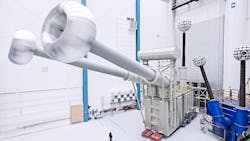The United States is still years away from a fully developed market for high-voltage, direct current (HVDC) transmission lines, but many experts believe it is coming with several projects underway. In the meantime, the market for direct current (dc) products in medium- and low-voltage applications are already here.
National Electrical Manufacturers Association (NEMA) members have identified a range of dc product design, performance, and testing requirements that are and/or will be needed as dc technologies become more integrated into the North American power grid. See below for an overview and information on how you can participate in developing these American National Standards.
Low-Voltage Transformers
Later this year, NEMA transformer manufacturers will begin work on two standards to address the use of low-voltage (LV) transformers in data centers. The data center industry is growing rapidly in the United States. The servers and cooling equipment require dc current, supplied through an LV ac transformer configuration coupled with a power conversion device such as a power distribution unit (PDU) or inverter. The transformers are typically rated at 480/208Y or 480/415Y or with a combined secondary in parallel series. These transformers are often located indoors and have unique environmental requirements such as temperature rise and airflow. There are also heightened equipment monitoring requirements, given the proximity to servers and valuable data. NEMA members intend to develop consensus standards for 1) transformer plus power conversion configuration for use in/around data centers; and 2) LV dc transformers for use in the same application.
Medium-Voltage Transformers
NEMA transformer manufacturers will also begin work on several standards to address the use of medium-voltage (MV) transformers in renewable generation applications. Renewable project developers regularly use an MV dc bus to interconnect solar PV and battery energy storage directly. Step-up and step-down transformers are required on both ends of the bus (≈1 kV to 24 kV). Also, grid planners frequently connect load centers such as small towns/cities with MV dc connections to facilitate greater power flow control and renewable penetration. The links are generally in the 24 kV to 36 kV range. Another possible development for renewable energy projects in the future is "green hydrogen," in which hydrogen fuel can be generated from renewable generation such as solar and wind. The process of creating green hydrogen involves electrolysis and these systems typically use rectifier transformers in converting grid ac power to dc power for the electrolysis process. NEMA members will develop consensus standards for dc transformers for use in these and other related applications.
High-Voltage Capacitors
NEMA capacitor manufacturers recently drafted a scope and outline to develop a consensus standard for dc capacitors. This standard is intended to provide a set of guidelines and test requirements to facilitate the specification of high-voltage capacitors for the dc-side of an HVDC system using line-commutated and/or voltage source converters. This will be the first standard governing capacitors for any dc application.
Medium- and High-Voltage Insulators
NEMA insulator manufacturers recently developed a consensus standard to harmonize design, performance, and testing requirements for glass and porcelain dc-rated insulators for overhead lines. Such standards already exist in IEC TC 36 (IEC 61325 dates from the mid-1990s) and Canada (CSA-C1325). The dc stress applied on glass or porcelain insulators implies specific features compared to normal ac units. Among those, the dielectric needs to consider an ionic migration phenomenon for which higher internal electric resistance is necessary; the metal end fittings need to be fitted with specific galvanic protection. NEMA intends to adopt the IEC requirements to the North American market introducing the specific type tests and sample tests.
Meters
The increasing need for reliable and resilient energy drives the development of distributed energy sources, including renewables. Dc technologies, including solar PV, batteries, and hydrogen fuel cells, are at the forefront of these technology developments. Additional dc meter applications are expected to quickly evolve as the interest in efficient dc services continues to expand. ANSI C12.32 has been created in response to a market need to measure dc energy sources and loads. ANSI C12.32-2021 was approved on March 4 and will soon be published.
NEMA is looking for product users and representatives of government and academia to participate in the standards development process. If you are interested, contact Jonathan Stewart ([email protected]) for further information.
About the Author
Jonathan Stewart
Jonathan Stewart is industry director, utility products and systems, National Electrical Manufacturers Association (NEMA).
